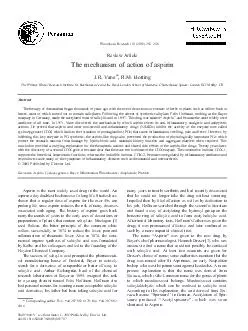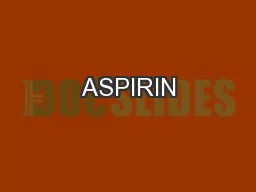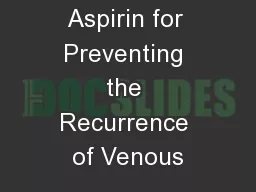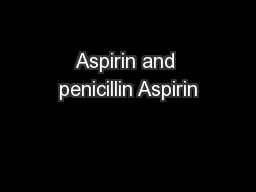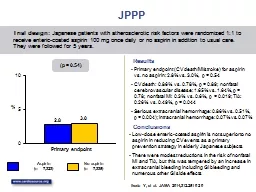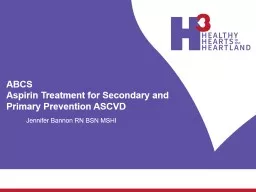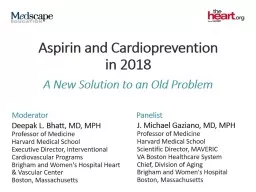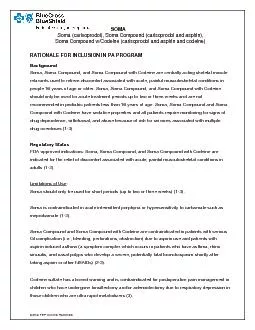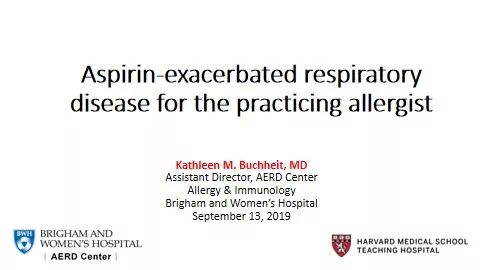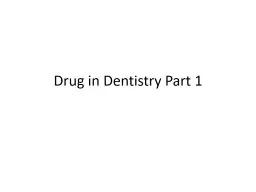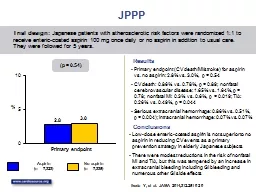PDF-Review Article The mechanism of action of aspirin J
Author : alexa-scheidler | Published Date : 2015-03-18
R Vane RM Botting The William Harvey Research Institute St Bartholomews and the Royal London School of Medicine Charterhouse Square London EC1M 6BQ UK Abstract The
Presentation Embed Code
Download Presentation
Download Presentation The PPT/PDF document "Review Article The mechanism of action o..." is the property of its rightful owner. Permission is granted to download and print the materials on this website for personal, non-commercial use only, and to display it on your personal computer provided you do not modify the materials and that you retain all copyright notices contained in the materials. By downloading content from our website, you accept the terms of this agreement.
Review Article The mechanism of action of aspirin J: Transcript
R Vane RM Botting The William Harvey Research Institute St Bartholomews and the Royal London School of Medicine Charterhouse Square London EC1M 6BQ UK Abstract The therapy of rheumatism began thousands of years ago with the use of decoctions or extr. Aspirin. Used as an analgesic (pain killer) for headaches, toothaches, neuralgia (nerve pain), muscle pain and joint pain.. Also effective as a fever reducer and anti-inflammatory.. Has anticoagulant properties – prevents strokes and heart attacks.. د. حسين محمد جمعة . اختصاصي الامراض الباطنة . . البورد العربي . كلية طب الموصل . . . . 2011. . . Thromboembolism. N . Engl. J Med. 2012;366:1959-67. VTE Prevalence. Incidence . of DVT: 48 per 100,000. Incidence of PE: 23 per 100,000. Case-fatality rate. Inpatient: 12%. 1-year: 19%; 3-year: 30%. The sensation of pain – our ability to perceive pain is one of our best defense mechanisms. . Pain allows us to act in a way that reduces further damage to our bodies. For example, removing the hand from a hot plate or not being able to continue running after pulling a muscle.. No aspirin (n = 7,335) JPPP Primary endpoint (CV death/MI/stroke) for aspirin vs. no aspirin: 2.8% vs. 3.0%, p = 0.54 CV death: 0.86 % vs. 0.78%, p = 0.89 ; nonfatal cerebrovascular disease: 1.65 Primary Prevention ASCVD. Jennifer Bannon RN BSN MSHI. Table of Contents. Objectives . Cardiovascular Disease. Cardiovascular Disease (2). ABCS-Aspirin when appropriate. Anatomy of a Performance Measure. in 2018. 3 Settings for Initiating Aspirin. Serious Vascular Events in Primary Prevention Trials. USPSTF Analysis. USPSTF 2016 Statement of Aspirin Use. Contemporary Clinical Trials Exploring the Role of Aspirin for Cardioprevention. as salicylic acid and its derivatives e.g. aspirin, and . paracetamol. , . block the transmission of pain from source . i.e. the injured tissue to . brain as they intercept the pain stimulus . at source. . SOMA Soma ( Soma Compound w/Codeine (carisoprodol and aspirin and codeine) Soma FEP Clinical Rationale RATIONALE FOR INCLUSION IN PA PROGRAM Background Soma , Soma Compound, and Soma Compound with Kathleen M. Buchheit, MD. Assistant Director, AERD Center. Allergy & Immunology. Brigham and Women’s Hospital. September 13, 2019. Conflict of Interest Disclosure . Relevant financial relationships with commercial interests in the preceding 12 months: Regeneron, Genentech. PAIN (ALGESIA). An unpleasant sensory and emotional experience associated with actual or potential tissue damage or described in terms of such damage.. ANALGESICS. A drug that selectively relieves pain by acting in CNS or on peripheral pain mechanism, without significantly altering consciousness.. Primary endpoint . (CV death/MI/stroke) for aspirin vs. no aspirin: . 2.8% vs. 3.0%, . p = 0.54 . CV . death: 0.86. % vs. 0.78%, . p = 0.89. ; nonfatal . cerebrovascular . disease: 1.65. % vs. 1.64%, . 89 non-cardioembolic stroke detected by rapid platelet function analyzer Jose C NAVARRO MD MSc , Annabelle Y LAO MD , Maricar P YUMUL MD , Maria Leticia C ARAULLO MD , Johnny K LOKIN MD , Aleja 50 Corresponding author: L RTICLERef: Ro J Neurol. 2021;20(1)DOI: 10.37897/RJN.2021.1.7listed as the primary causes of death and disability JOLOGY – VOLUME XX, N 51 Aspirin and non-steroidal an
Download Document
Here is the link to download the presentation.
"Review Article The mechanism of action of aspirin J"The content belongs to its owner. You may download and print it for personal use, without modification, and keep all copyright notices. By downloading, you agree to these terms.
Related Documents

